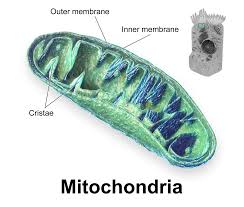Most eukaryotic cells contain an organelle known as the mitochondria now the number of mitochondria found in any given cell depends on the type of cell we are talking about some cells contain thousands of mitochondria while some cells contain only one now mitochondria are basically membrane-enclosed organelles that are responsible for forming the majority of the energy that is used by the cell and we form the energy the cells form the energy in the form of chemical molecules known as ATP or adenosine triphosphate.
now because of this because the mitochondria produces the majority of the energy that the cell uses we commonly refer to the mitochondria as the nuclear power plant of our cell because it produces the energy that basically powers the different types of processes that take place within our eukaryotic cells as well as within that eukaryotic multicellular organism now there is a theory known as the symbiotic theory that basically states or describes the way that we obtained the way that eukaryotic cells obtain that mitochondria so it's believed that eukaryotic cells essentially engulf some type of prokaryotic cell such as a bacterial cell and then eventually that bacterial cell developed into our mitochondria and this theory is known as the symbiotic theory so basically there is a symbiotic relationship between the eukaryotic cell and our prokaryotic system that eventually became our mitochondria now what exactly are some other functions of our mitochondria so other notable functions of the mitochondria organelle include program cell death known as apaptosis.
calcium signaling as well as cellular differ and she Asian so what exactly is a pitocin so a pitocin is basically the ability of the mitochondria to release some type of molecule that essentially kills off our cell and this is similar to the way that nuclear power plants can meltdown and cause lots of them damage so you can imagine in the same analogous way the mitochondria which is the nuclear power plant of our cell can basically lead to cell death now when exactly would this be useful well when we discuss embryology we're going to see that the way that we form our fingers on the hand is a result of the fact that our mitochondria is capable of killing off that cell and that process is a pitocin so the way that we're able to basically create our five fingers is a result of apatow --ss now what exactly is calcium signaling well basically the outer membrane of our mitochondria can associate with the membrane of the endoplasmic reticulum and that creates different types of important signaling pathways using calcium now cellular differentiation is another important concept in embryology so we'll talk about that when we get to embryology it's basically the ability of mitochondria to direct the differentiation of cells from an undifferentiated cell to a differentiated cells such as for example a muscle cell or a nerve cell now what exactly is the structure of a single mitochondrion so each mitochondrion consists of two phospholipid bilayer membranes one is called the outer membrane.
so we have the outer membrane as well as an inner membrane now notice that the inner membrane creates these in folds and these in folds are known as Christine and the reason we create these in folds is to increase the surface area of our inner membrane to basically be able to fit many more proteins into our inner membrane because proteins in the inner membrane are very important as we'll see in just a moment now the space between the outer membrane and the inner membrane is known as the inter membrane space or the peri mitochondrial space and finally the innermost space within our mitochondria the space that is basically below our inner membrane is known as the mitochondrial matrix and that is also a very important region as we'll see in just a moment that's the location where the krebs cycle also known as the citric cycle takes place so let's begin by basically looking at every single one of our structures and see why each structure is important let's begin with the outer membrane now the outer membrane is a phospholipid bilayer it's basically the same type of membrane that is found around that cell so the outer membrane is a phospholipid bilayer and it contains a protein lipid composition that is very similar to the protein lipid composition of the plasma membrane of the cell now the outer membrane also contains special type of large integral proteins proteins that span the entire outer membrane known as porins and these porns can basically allow certain types of small molecules to pass through via the process of facilitated diffusion so down the electrochemical gradient without using any type of energy source so for instance these large integral proteins can allow the molecule called pyruvate as well as NADH to pass through our outer membrane so when we discuss the process of glycolysis when we basically break down glucose we produce the molecule per ovate as well as an ADH and pyruvate and nadh can basically be broken down further inside the mitochondrial matrix.
so it's very important for these molecules to actually be able to pass through the outer membrane with ease and that's exactly why we have these proteins called porins that act as carrier proteins and transport these molecules into our inter membrane space now let's move on to our inter membrane space so also known as the peri mitochondrial space this is the region between the outer membrane and our inner membrane this is this region here shown by this arrow now since the outer membrane is permeable to small ions and molecules that implies that the concentration of the ions and molecules in a sinus all is the same as the concentration of these small molecules and ions inside the inter membrane space now even though the outer membrane is permeable to small molecules and ions it's not permeable to large proteins and so the types of proteins we'll find in a cytosol is different the type of proteins we'll find in our inter membrane space now let's move on to our inner membrane the inner membrane is arguably one of the most important structures within our mitochondria so the inner membrane contains a much higher protein concentration than the outer membrane and it is impermeable to essentially all our ions and molecules and because of that it contains a multitude of proteins that act as integral proteins to basically carry the molecules from our inter membrane space into the mitochondrial matrix for example the NADH molecule that can easily pass through the poor and integral proteins found on our outer membrane cannot pass through our inner mem and a special type of protein that uses ATP has to basically carry that nad my nadh molecule from our inter membrane space into that mitochondrial matrix where it is then basically broken down to produce the ATP molecule to basically create the electrochemical gradient and produce our ATP molecules
so we see that our inner membrane is impermeable to essentially all ions and molecules and contain a multi proteins that shuttle molecules into and out of our matrix now it also contains a series of proteins known as our electron transport chain or etc' and this these are the series of proteins that are basically responsible for setting up an electrochemical gradient between the matrix and our inter membrane space for our ATP synthase protein to basically create that ATP molecule that we use as our energy source now let's move on to our mitochondrial matrix so the mitochondrial matrix is this area here and it contains the majority of the proteins found in our mitochondria and most of these proteins basically act as enzymes in our citric acid cycle in the Krebs cycle which basically involves the breaking down of pyruvate using our molecule acetyl coenzyme a as well as other things to basically create our ATP molecules with the help of the electron transport chain now the mitochondria also can take warm the mitochondrial matrix also contains the mitochondrial DNA along with the mitochondrial RNA






Comments
Post a Comment